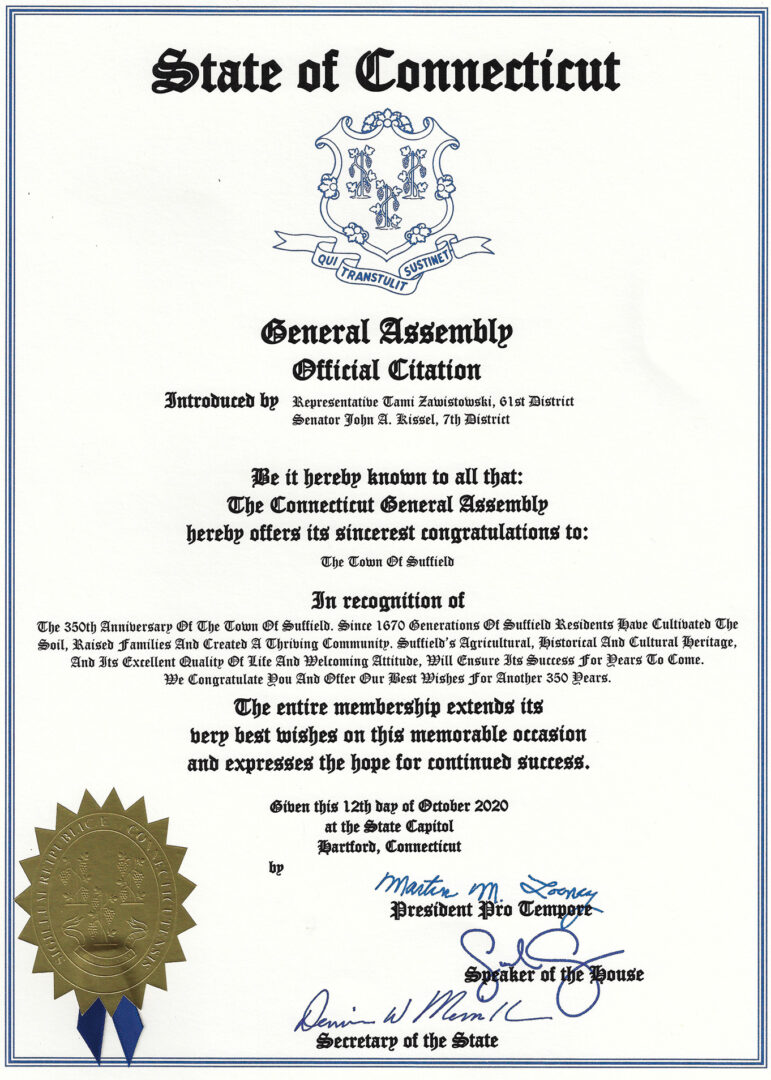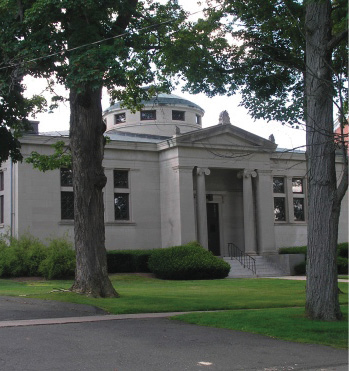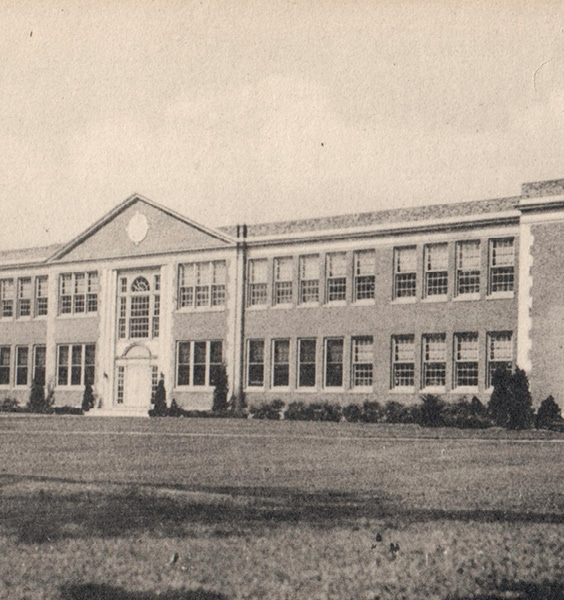Legend: Events in or about Suffield are blue.
1620 – Pilgrims land at Plymouth Rock.
1638 – First European settlement in Connecticut, at Wethersfield
1638 – First written constitution in the world: Connecticut’s Fundamental Orders
1647 -First witch executed in the American colonies, at Windsor.
1669 – John Pynchon, Suffield’s founder, buys land for Suffield from local Indians for 30£.
1670 – October 12. Massachusetts General Court issues grant for a plantation at Stony River called Southfield. First settlements made.
1670-1682 – Pynchon and his committee grant lots to almost 100 “original proprietors.”
1672 – Pynchon builds a sawmill near the mouth of Stony Brook, adds gristmill in 1677.
1674 – Southfield incorporated as Suffield. First child born (Mindwell Old).
1675 – King Philip’s War flares; Town abandoned, burned by hostile Indians. Settlement resumes in 1677.

1680 – First meeting house built. John Younglove hired as first minister.
1682 – Thirty-four qualified voters hold first town meeting. Town officers elected.
1696 – First full-time schoolmaster hired: Anthony Austin.
1701 – Pynchon sets up an iron works on Stony Brook, near the present East Street. Eventually there were two more, all on Stony Brook.
1710 – A fulling mill is approved on Stony Brook near the present end of South Main Street, also a cotton yarn mill there, among the first mills of a growth of manufacturing in Suffield.
1740 – Church divides over meeting house seating and other matters; Second Ecclesiastical Society incorporated. Building erected in 1744 at southwest corner of West Suffield Cemetery.
1744 – Ishmael, a fugitive slave, becomes the first Black landowner in town, having been voted a small parcel.
1749 – Suffield becomes part of Connecticut, after many years of colony boundary argument.
1754 – 1763 – French and Indian Wars: Phinehas Lyman the Suffield lawyer who led the boundary settlement, becomes a major general in the French and Indian Wars; 91 men from Suffield served.
1755 – Connecticut Gazette launched
1762 – First Connecticut Blue Laws codified
1764 – First issue of the Connecticut Courant
1769 – Joseph Hastings and other Separatists, encouraged by the Second Great Awakening, establish on Hill Street the first Baptist Church in Hartford County.
1774-1784 – Suffield provides strong assistance in the effort to achieve independence, issuing a declaration of resistance in 1774; sending 111 men off to Boston in response to the Lexington Alarm In April 1775, and sending 250 in all to serve in the war.
1775 – 1783 – American Revolutionary War
1775 – General George Washington stops in Suffield on his inspection trip to Boston. He addresses a crowd on the Green, lunches at the Austin Tavern across the street, then continues on his way.

1776 – American Declaration of Independence signed.
1787 – U.S. Constitution written.
1791 – U.S. Bill of Rights
1792 – First American women-only school opens, in Litchfield
1794 – Eli Whitney invents the cotton gin.
1796 – First Suffield Post office established, with Hezekiah Huntington as postmaster.
1797 – 1799 –The Impartial Herald newspaper is published in Suffield.
1801 – The Franklin Paper Mill is built near the mouth of Stony Brook. The mill operates until 1914; its remains were washed out in the 1955 flood.
1804 -1807 – Lewis and Clark Expedition explores American Northwest.
1805 – Second Baptist Church is established to serve the eastern population of town. The first building was built in 1810. The present building was built in 1840.
1806-1814 – Hartland Turnpike established, extending from Suffield to Norfolk.
1806 – Noah Webster prints first American dictionary, in New Haven.
1809 – First bridge across the Connecticut River in Connecticut is built. It was replaced in 1832 by a covered bridge that was washed out in 1900 by an ice-jammed freshet. New iron bridge at Thompsonville opened in 1894.
1810 – First cigar factory in the United States opens, established by Simeon Viets on Ratley Road. Tobacco growing and cigar manufacturing flourished in subsequent years.
1812 – The War of 1812: Suffield sent 18 men to this war.
1816 – Eagle Paper Mill is built, a mile upstream from the Franklin Mill. It burned in 1877.
1818 – Rev. Asahel Morse of Suffield’s First Baptist Church wrote Section Seven of the new Connecticut Constitution, officially separating Christian church and state.
1820 – Masonic Lodge established in Suffield.
1829 – Enfield Falls Canal opens, allowing boats to bypass Connecticut River shallows and providing power to future mills at Windsor Locks.

1833 – Connecticut Baptist Literary Institution opens. The “Baptist” was soon dropped. The school was later named Suffield School and is now Suffield Academy.
1835 – Farmington Canal opens from New Haven to Northampton, passing through the west end of Suffield. The canal soon failed and was replaced in 1848 by a railroad.
1836 – Samuel Colt invents the first revolving cylinder for firearms.
1837 – Post Office opens in West Suffield, with Erastus Weed, as first postmaster.
1839 – The first Methodist church in Suffield is built, after services in private homes. It closed in 1920 when membership dwindled and served as a tenement until it burned.

1840 – The Graham cracker is invented, following the teachings of Suffield’s dietary and behavioral crusader Sylvester Graham.
1861-1865 – U.S. Civil War: Suffield sends 286 men to fight, with 15 lost. The Soldiers Monument was dedicated in 1888.
1861 – Town Hall burns. New Town Hall is built in 1862 on the site of the old building, which had been moved there from the Green. Both buildings served as the Center School District schoolhouse as well.

1864 – First National Bank chartered. It was purchased by PeoplesBank of Holyoke in 2019.
1864 – Travelers Insurance established in Hartford, with many Suffield investors and officials.
1865 – Calvary Episcopal Church organized. Its first building opened in 1872, but closed and was demolished in 1923.
1865 – Lincoln assassinated.
1869 – Suffield Savings Bank opens as a mutual bank. Becomes a stock corporation in 1984, fails in 1991, closed by a federal agency. Now a branch of Webster Bank.
1870 – Railway branch line connects main line at Windsor Locks to Suffield. Along with the railroad, the telegraph brings fast communication to Suffield.
1870 – Suffield celebrates Bicentennial Anniversary.
1875 – The town’s first public library is organized, following several subscription libraries. Opens in rented quarters the following year.
1876 – First record of fire equipment bought: two hand-drawn pumps.
1876 – Alexander Graham Bell is credited with inventing the first telephone.
1878 – Required by State law, Suffield begins sending secondary school students to what is now Suffield Academy.
1880 – Suffield Grange established, occupies Mapleton Hall.
1882 – Sacred Heart Church organized. First building opens in 1886, drastically remodeled in 1938, replaced in 1985.
1893 – The Village of Suffield is established as a governmental borough occupying the Center School District. Within a few years the Village brought piped water, electricity, sidewalks and, in 1896, a volunteer fire department,
1896 – First Henry Ford car produced.
1896 – First moving pictures are shown, in U.S.

1899 – Sidney A. Kent gives Suffield a new public library building, built on land of his original settler ancestor, Samuel Kent. In 1972, when the Kent Memorial Library moved across the Green to the former location of the Town Hall, the old library became the Sidney Kent Legare Memorial Library of Suffield Academy.
1900 – First automobile comes to town, a Stanley Steamer owned by Apollos Fuller.
1901 – First tobacco grown under cloth, by W. S. Pinney of Suffield.
1901 – First automobile ride by a President: William McKinley
1902 – Central New England Railroad connection opens, with depot in West Suffield center.
1903 – Third Baptist Church organized. Church building opens in 1906.
1903 – Emergency Aid Association organized, now Suffield Community Aid.
1905 – Saint Joseph Church organized. Church building opens in 1916. New building dedicated in 1952. Merges with Sacred Heart Church in 2017.
1905 – San Francisco Earthquake
1912 – Titanic sinks.
1914 – Panama Canal opens.
1914 – 1919 – World War I: U. S. enters in 1917; Suffield sends 198 men and women to serve, four die in service.
1918 – Suffield schools shut down briefly in world flu pandemic
1920 – Suffield celebrates its quarter-millennial anniversary, including a grand historical pageant attended by more than the population of the town.
1920 – Hundreds of Suffield women register to vote for the first time, following the approval of the nineteenth Federal Constitution amendment.
1920 – 1933 – Prohibition in the U.S.
1922 – First radio station in Connecticut: WDRC, followed closely by WTIC.
1929 – 1934 – The Great Depression
1930 – Leon Buczynski is elected to the Board of Selectman, the first of Polish heritage to take a key role in Suffield Town government.
1932 – First Suffield zoning districts are established.

1939 – Suffield’s first high school opens. Now McAlister Intermediate School.
1939- 1945 – World War II: U. S. enters in 1941, after Japanese attack on Pearl Harbor.
Suffield sends 563 men and women; 15 die in service.
1940 – Suffield Historical Society established.
1941 – Town Forest established. Named Jesse Fowler Smith Memorial Forest in 1959.
1941 – Police Commission named. First town police force established; Harold Hill, chief.
1944 – First town fire department; Frank Smith, chief.
1945 – United Nations Established
1945 – First atomic bombs end World War II. (U.S.)
1948 – First LP records
1949 – Calvary Episcopal Church is revitalized. New building is erected in 1951 across the street from its predecessor. Membership dwindles, church merges in 2007 with two churches in Enfield.
1950 – 1963 – Korean War. Suffield sends 170 men; none die in service.
1951 – Suffield Council of Churches organized. Later becomes Interfaith Council.
1956 – IBM introduces first computer hard drive. Rapid development of integrated circuits and personal computers allows IBM to introduce their first PC in 1975.
1957 – Good Shepherd Lutheran Church organizes, builds on South Street.
1959 – 1975 – Vietnam War: Suffield has 166 men and women in service.
1961 – 1969 – Berlin Wall intensifies Cold War.
1962 – Cuban missile crisis creates widespread concern about impending attack.
1963 – St. Alphonsus College Seminary opens on the grounds of George Hendee’s Hilltop mansion. School closes in 1990 and is later used by Lincoln Institute for their Connecticut Culinary Institute and other schools.

1965 – Town purchases land on West Suffield Mountain, creates Sunrise Park.
1966 – Suffield-Enfield Veterans Bridge opens, crossing the Connecticut River to Thompsonville. 1894 bridge to Thompsonville soon closes.
1967 – Frances Woods is first women elected to the Board of Selectmen.
1967 – Maple Court assisted housing for elderly built, followed by Laurel Court in 1971, Broder Place soon after.
1967 – Six Day War (Middle East)
1968 – Charles Bissell donates land for Stony Brooke Park to the town.
1970 – Suffield celebrates its tercentennial anniversary, including opening the Suffield Village. Shopping Center, which culminated a major redevelopment in Suffield Center.
1972 – New Kent Memorial Library built on site of old Town Hall.
1976 – Suffield celebrates U.S. Bicentennial anniversary.
1977 – Babb’s Beach given to the town by Babb Family.

1980 – Bruce Memorial Park development voted.
1980 – 1983 – Iran-Iraq War
1981 – AIDS virus identified.
1984 – Park Place opens on Bridge Street: assisted housing for elderly.
1986 – Space Shuttle Challenger explodes after lift-off, seven astronauts die.
1988 – Chernobyl nuclear power plant explodes in Russia.
1990 – www is born.
1991 – First Connecticut state income tax imposed.
1992 – Walker Reception Center opens, with MacDougall Correctional Institution the following year. Built after Town negotiations that provided a large water tower serving the South Street Industrial Center, improvements to the sewage treatment facility, and a large yearly payment in lieu of taxes.
1999 – Construction of Space Station Alpha begins (USA, Russia, Europe).
1999 – Volunteers assembled by Sam Fuller begin publishing The Suffield Observer.
2000 – Human Genome mapped (US and United Kingdom).
2001 – NASA lands Odyssey probe on Mars.

2001 – 9/ll terrorist attacks. First responders from Suffield join rescue effort in New York.
2003 – Construction begins on new sidewalks in Suffield center, funded by state grant. 2003 – Suffield Veterans Memorial is dedicated.
2003 – Space shuttle Columbia explodes upon reentry, killing seven astronauts.
2003 – War with Iraq begins.
2005 – Hurricane Katrina devastates the Gulf coast.
2007 – Apple introduces first iPhone.
2008 – Barack Obama becomes first African-American President.
2008 – Great Recession begins.
2008 – Suffield buys former Calvary Episcopal Church building, converts it to serve as the Suffield Senior Center.
2008 – The two Suffield prisons merge to become the MacDougall-Walker C. I., the largest prison in Connecticut.
2011 – Major snow and ice storm closes town; Suffield emergency shelter opens for a week in Suffield High School.
2012 – Suffield library reopens after roof repair and interior remodeling. Project was approved after three attempts to expand or build elsewhere are voted down.
2013 – U.S. government shuts down when Congressional stalemate allows funding to run out.
2015 – Same sex marriage becomes legal in the U.S.
2015 – Library closes for new accessible entrance and major upgrade; reopens in 2019 after closing was extended for remediation of discovered PCB contamination.

2017 – Millions march for women’s rights in U.S.
2020 – Suffield Schools close in March in response to COVID-19 pandemic. Reopen in fall with hybrid program of in-school and remote learning.
2020 – Suffield Town Hall closes for long-awaited major upgrades and renovation.
2020 – Black Lives Matter movement becomes a powerful force for social change.
